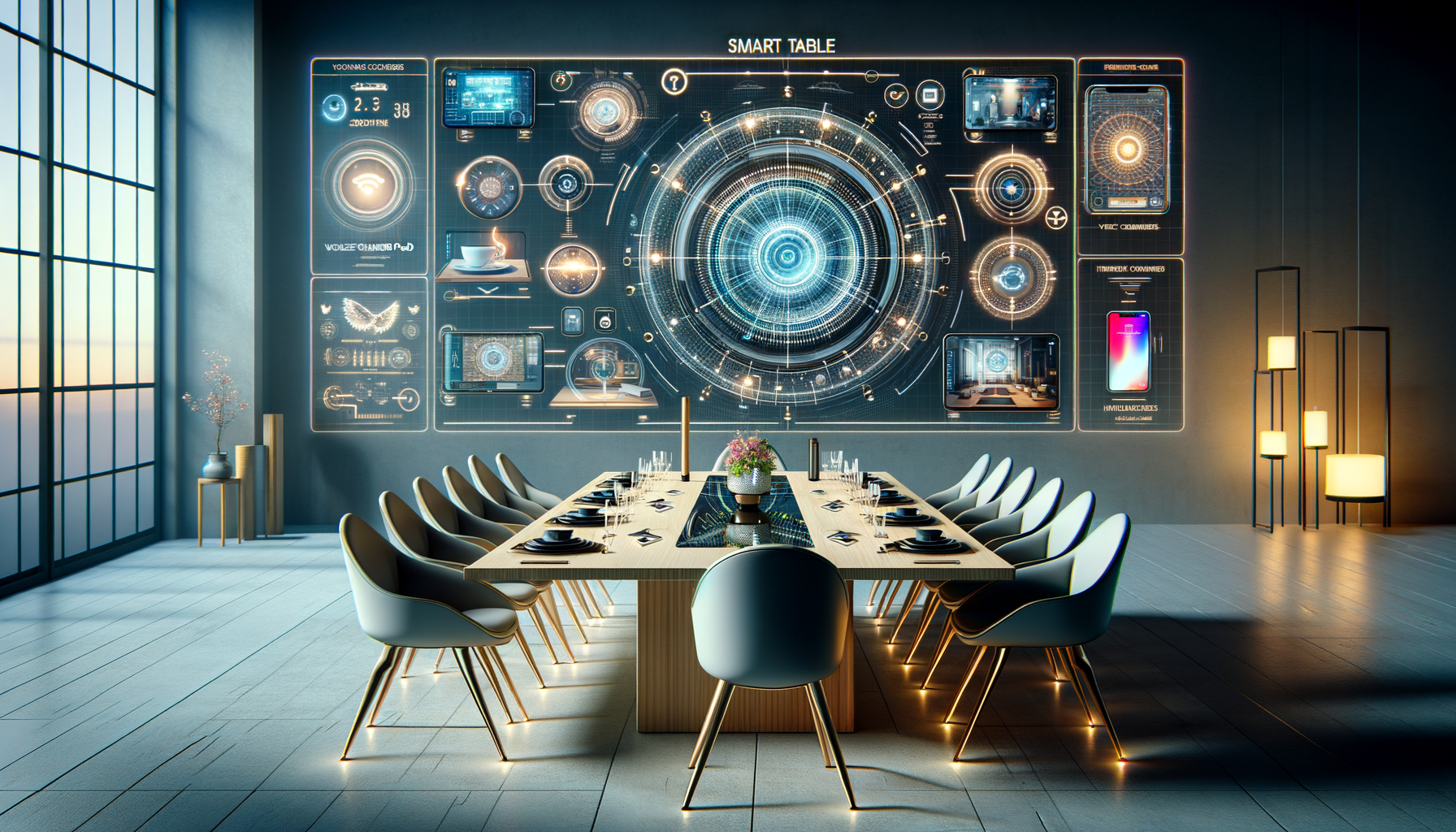
Understanding the Rise of Tech-Integrated Furniture
The Evolution of Smart Tables: A Blend of Design and Technology
Smart tables have emerged as a fascinating intersection of design and technology, transforming traditional furniture into multifunctional pieces that cater to modern needs. These tables are not just about aesthetics; they integrate advanced features that enhance usability and convenience. From wireless charging capabilities to integrated speakers and smart home controls, smart tables are redefining the way we interact with our living spaces. The evolution of these tables can be traced back to the increasing demand for furniture that complements the digital lifestyle. As more people work from home and seek seamless connectivity, smart tables offer a solution that blends functionality with style.
Historically, furniture served a singular purpose, but with technological advances, the lines between utility and innovation have blurred. Today’s smart tables are equipped with various features that cater to different needs, such as built-in USB ports, Bluetooth connectivity, and even voice control. These enhancements are designed to simplify daily tasks, making them an attractive proposition for tech-savvy individuals.
The rise of smart tables is also driven by the growing trend of compact living. In urban areas where space is a premium, multifunctional furniture like smart tables can maximize utility without compromising on style. As technology continues to advance, the potential for smart tables to offer even more integrated solutions will only increase, making them a staple in future homes.
Key Features and Innovations in Smart Tables
Smart tables are equipped with a range of innovative features that cater to the needs of modern users. These features are designed to enhance convenience, connectivity, and functionality, making them a popular choice among those seeking tech-integrated furniture solutions.
One of the standout features of smart tables is wireless charging. With the proliferation of wireless devices, having a table that can charge your gadgets without the need for cables is a significant advantage. This feature is particularly useful in living rooms and offices where multiple devices are used frequently.
Another popular feature is the integration of smart home controls. Some smart tables come with built-in touch panels or voice assistants that allow users to control lighting, temperature, and other smart devices in the home. This integration streamlines the user experience, allowing for a more cohesive and connected living environment.
Additionally, smart tables often include Bluetooth speakers, offering a convenient way to play music or take calls. This feature is particularly appealing for those who enjoy hosting gatherings or simply want to enhance their audio experience at home. Some tables also come with LED lighting, which can be customized to suit different moods and settings.
Overall, the innovations in smart tables are centered around enhancing the user experience by providing seamless connectivity and multifunctionality. As technology continues to evolve, we can expect even more advanced features to be incorporated into smart tables, further enhancing their appeal and utility.
Comparing Smart Tables to Traditional Furniture
When comparing smart tables to traditional furniture, the differences extend beyond aesthetics and delve into functionality and user experience. Traditional tables are designed primarily for static purposes, such as dining or holding items, whereas smart tables offer dynamic features that cater to the needs of a tech-driven lifestyle.
One of the primary distinctions is the integration of technology. Traditional tables lack the connectivity and interactive features found in smart tables. For instance, while a traditional coffee table might serve as a decorative centerpiece, a smart coffee table could double as a charging station, entertainment hub, and control center for various smart home devices.
Furthermore, smart tables are designed with user convenience in mind. Features such as wireless charging, Bluetooth speakers, and smart home integration are not only about adding value but also about enhancing the overall user experience. In contrast, traditional furniture often requires additional accessories to achieve similar levels of functionality, which can lead to clutter and inconvenience.
However, it is essential to consider that traditional furniture has its own set of advantages. It often offers a timeless aesthetic appeal and can be more affordable than its smart counterparts. Additionally, traditional furniture does not require power sources or technical maintenance, making it a low-maintenance option for those who prefer simplicity.
In conclusion, while traditional furniture offers classic appeal and simplicity, smart tables provide a modern solution that aligns with the needs of a tech-savvy audience. The choice between the two ultimately depends on individual preferences and lifestyle requirements.
The Impact of Smart Tables on Modern Living Spaces
The introduction of smart tables into modern living spaces has significantly impacted how people interact with their environments. These tables offer a blend of functionality and style that caters to the demands of contemporary life, making them an increasingly popular choice for homeowners and designers alike.
One of the most notable impacts of smart tables is their ability to enhance space efficiency. In urban settings where living areas are often limited, smart tables provide multifunctional solutions that maximize utility without occupying excessive space. This is particularly beneficial for small apartments or homes where every square foot counts.
Moreover, smart tables contribute to a more connected and integrated living environment. With features like smart home controls and wireless connectivity, these tables allow users to manage various aspects of their home from a single point. This integration simplifies daily routines and creates a more cohesive living experience.
Smart tables also play a role in sustainable living. Many models are designed with energy-efficient features and are made from sustainable materials, aligning with the growing trend of eco-friendly living. This aspect appeals to environmentally conscious consumers who seek to reduce their carbon footprint while enjoying the benefits of modern technology.
In summary, smart tables have transformed modern living spaces by offering innovative solutions that enhance functionality, connectivity, and sustainability. As technology continues to advance, the role of smart tables in shaping the future of interior design will likely expand, offering even more possibilities for creating efficient and stylish living environments.
Future Trends in Smart Table Design
The future of smart table design is poised to bring even more exciting innovations as technology continues to evolve. Designers and manufacturers are exploring new ways to integrate advanced features into furniture, making smart tables a focal point in the development of smart homes.
One anticipated trend is the increased use of artificial intelligence (AI) in smart tables. AI can enhance the functionality of these tables by learning user preferences and adapting to their needs. For example, a smart table could automatically adjust lighting or temperature settings based on the time of day or user activity, creating a more personalized experience.
Another trend is the incorporation of augmented reality (AR) and virtual reality (VR) features. These technologies can transform a smart table into an interactive display, offering new possibilities for entertainment, education, and work. Imagine a coffee table that can project a virtual board game or a dining table that provides interactive cooking tutorials.
Furthermore, as sustainability becomes increasingly important, future smart tables are likely to prioritize eco-friendly materials and energy-efficient features. This focus on sustainability will not only appeal to environmentally conscious consumers but also contribute to the broader movement towards sustainable living.
Lastly, the integration of more advanced connectivity options, such as 5G, will enhance the capabilities of smart tables, enabling faster and more reliable connections with other smart devices. This advancement will further streamline the user experience, making smart tables an indispensable part of the smart home ecosystem.
In conclusion, the future of smart table design is bright, with numerous possibilities for innovation and integration. As technology continues to advance, smart tables will undoubtedly play a significant role in shaping the future of interior design and smart living.


